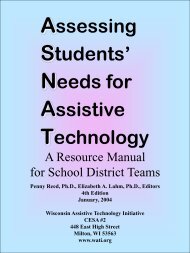Extended School Year Services (ESY) - The Special Education Team
Extended School Year Services (ESY) - The Special Education Team
Extended School Year Services (ESY) - The Special Education Team
You also want an ePaper? Increase the reach of your titles
YUMPU automatically turns print PDFs into web optimized ePapers that Google loves.
SCENARIO: ANTONIO<br />
7/1999<br />
Revised 8/2004<br />
Background Information<br />
Antonio is a second grade student of above average intelligence and good social skills.<br />
At the end of first grade, Antonio was determined eligible for special education in the<br />
area of learning disabilities due to a significant reading disability. Antonio is well liked<br />
by his teachers and peers and has a strong desire to succeed. In the area of math, he is<br />
on grade level and enjoys helping his peers. <strong>The</strong> only time that he has difficulty during<br />
math class is when he is required to read.<br />
Antonio's language skills are good. He has average expressive language skills for a<br />
student his age and has very good receptive skills. Antonio can understand ageappropriate<br />
materials that are read to him. Antonio's listening comprehension skills<br />
allow him to listen to and understand the material read in science or social studies. For<br />
example, he is able to repeat factual information and make some inferences from the<br />
information heard.<br />
In spite of his strong motivation and such good skills in many areas, Antonio has<br />
consistently demonstrated difficulty with every aspect of reading since kindergarten.<br />
During his kindergarten year, when Antonio was introduced to the names of the letters<br />
in his first name, he had trouble immediately. This trouble was compounded as each of<br />
the 26 letters in the alphabet was introduced. Antonio had great difficulty remembering<br />
the letter names and this was only heightened by letters with very different upper and<br />
lower case symbolization (such as "q" and "Q"). Because of this, learning "sight words"<br />
was laborious and seemingly impossible.<br />
Given these difficulties, it was not hard to predict that when Antonio was asked to learn<br />
and recall the sound associated with each letter, it would be almost an impossible task.<br />
In addition, when Antonio would listen to his teacher demonstrate how to put letter<br />
sounds together into words (e.g., /c/, /a/, /t/=cat), he would have a look of awe and<br />
disbelief on his face, perhaps representing how foreign this process was to him at that<br />
time.<br />
Antonio's IEP called for special education (LD) intervention for all of language arts<br />
(reading, spelling, writing, vocabulary development) and specific modifications for his<br />
regular education classroom to address his reading/writing difficulties which would<br />
impact on his other academic subject areas. During the current school year (2nd grade),<br />
Antonio's special education teacher worked hard to teach him the letter/sound<br />
relationships and their association with the world of reading. During March, she began<br />
to use yet another approach and she began to see the first glimmer of understanding<br />
from Antonio. Gradually, over the next 4-6 weeks, when presented with sound-symbol<br />
associations and sound blending models, the look of disbelief on Antonio's face began to<br />
be replaced with a look of understanding. Whatever the reason for the turn-around,<br />
actual progress began to take place. Antonio began to learn and recall some of the<br />
consonant sounds and some short vowel sounds. He also began to associate the words<br />
CESA #9: 1999 Determining <strong>ESY</strong> <strong>Services</strong>, Revised 2004 18











